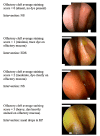Delivering Therapy to the Olfactory Cleft: A Comparison of the Various Methods of Administering Topical Nasal Medications
- PMID: 38445151
- PMCID: PMC10912055
- DOI: 10.7759/cureus.53523
Delivering Therapy to the Olfactory Cleft: A Comparison of the Various Methods of Administering Topical Nasal Medications
Abstract
Background and objective Chronic rhinosinusitis (CRS) is an inflammatory condition affecting the nasal mucosa, and it causes olfactory dysfunction (OD) in up to 78.2% of patients. Corticosteroids are the mainstay of treatment to shrink nasal polyposis, reduce inflammation, and improve olfactory function. While many delivery methods for topical nasal corticosteroids exist, there is scarce data on the efficacy of the various medication delivery methods to the olfactory cleft (OC). In light of this, this study aimed to compare the following delivery methods to the OC: conventional nasal spray (NS), nasal drops in the Kaiteki position (KP), and exhalation delivery system (EDS). Methods We evaluated 16 sinonasal cavities from eight cadaver specimens in this study. Each sinonasal cavity was administered fluorescein dye solution via NS, KP, and EDS. Following administration, nasal endoscopy was employed to capture staining patterns in the OC. OC staining was rated with scores ranging from 0 (no staining) to 3 (heavy staining) after each administration of dye solution. Mean OC staining ratings were calculated and compared using the Kruskal-Wallis rank sum test and the Wilcoxon signed-rank test. Results The mean OC staining score for the different delivery methods was as follows - NS: 1.095 ± 1.008, EDS: 0.670 ± 0.674, and KP: 2.038 ± 1.097. Nasal drops in the KP had a significantly higher staining score compared to NS (p=0.041) and EDS (p=0.003). However, there was no significant difference in staining scores between NS and EDS. Conclusions Nasal drops in the KP are more effective at reaching the OC than NS or EDS and should be considered as a first-line modality for administering topical medications when treating OD.
Keywords: chronic rhinosinusitis; exhalation delivery system; kaiteki; nasal spray; olfactory cleft.
Copyright © 2024, Jacobson et al.
Conflict of interest statement
The authors have declared that no competing interests exist.
Figures



References
-
- Epidemiology of chronic rhinosinusitis: prevalence and risk factors. Sedaghat AR, Kuan EC, Scadding GK. J Allergy Clin Immunol Pract. 2022;10:1395–1403. - PubMed
-
- International consensus statement on allergy and rhinology: rhinosinusitis 2021. Orlandi RR, Kingdom TT, Smith TL, et al. Int Forum Allergy Rhinol. 2021;11:213–739. - PubMed
Grants and funding
LinkOut - more resources
Full Text Sources
Miscellaneous
